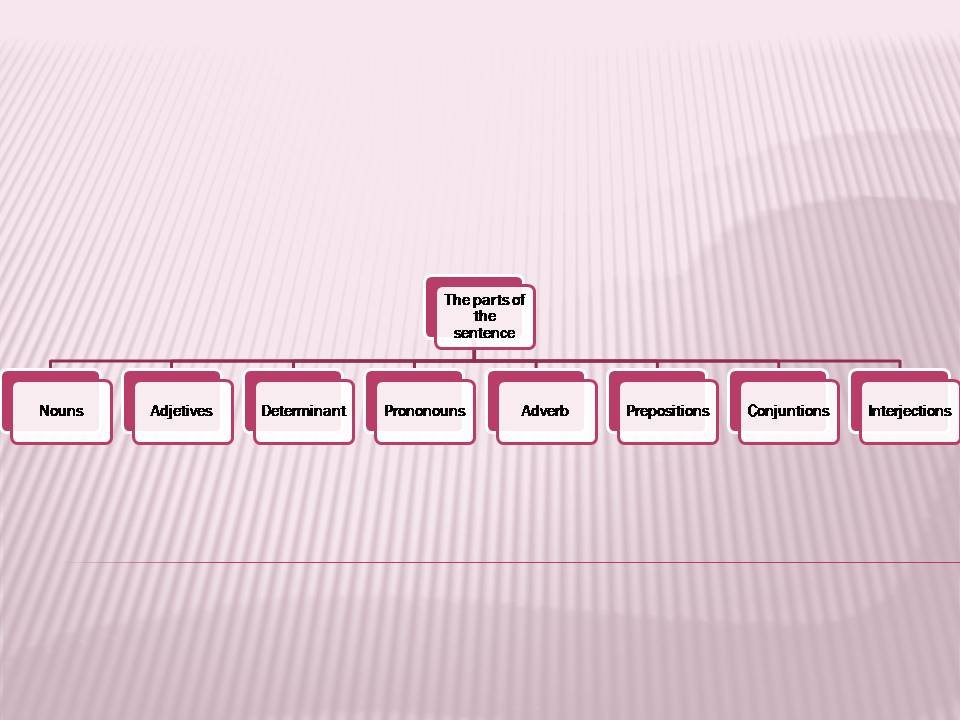The parts of the sentence are different kinds of words and among them we have: nouns, adjectives, determinants, pronouns, verbs, adverbs, prepositions, conjunctions and interjections. In this post we are going to talk about what are these kinds of words and what are the types or the classification that exists within them. I know it sound a little complicated.

Let’s start with the Nouns:
The nouns are those that refer to the beings, objects or ideas that we have in the sentence; between the different types of nouns we have: the common, the own, the concrete, the abstract, the individual, collective, countable and uncountable. Nouns must have gender and number; and the adjective and the determinants must coincide with the gender and the noun number. The gender can be feminine or masculine depending on the termination of the word and the number can be plural or singular depending on whether it refers to a single unit or several units.
For example: La casa es grande
Now Adjectives
Adjectives describe the noun or a pronoun basically adjectives are capable of modifying the noun or pronoun. These adjectives can be positive, comparative, comparative equality, superlative, possessive and demonstrative. Adjectives generally go after the noun although there are some exceptions where the adjective can precede the noun.
For example: La chica es inteligente
Now let’s talk about the Determinants
Basically the determinants accompany the noun and generally must coincide in gender and number with the noun. Among them we have articles that can be defined or undefined: those defined are generally those that are used for something known and those that are undefined for the unknown.
For example: La oficina está lejos
The Pronouns
The pronouns replace the noun. We will have different types of pronouns. We can have personal pronouns that will be represented by the grammatical person, possessive: things or ideas possessed, objectives that replace the direct complement, interrogation: beings or things whose identity is unknown, relative: substantive expressed in the omitted sentence that has already been mentioned before, demonstratives that replace the noun and denote distance with respect to who speaks, undefined: beings things or ideas whose identity or quantity is imprecise, and the reflexive that verbal action goes towards the subject.
For example: Ella es mi mama
Then we have the Adverbs
Adverbs complement the verb, the adjective or another adverb. Can be: place, time, quantity, manner, affirmation, negation, and doubt; usually they are located before the adjective that they modify but after the verb. Many are created by adding the word “-mente” to the singular feminine form of an adjective, but not all of them exist that are exceptions to this.
For example: Ella hizo exactamente lo que le pedí
When we talk about Prepositions
We must understand that these are words that link words. Many verbs require a preposition after the verb.
For example: Yo voy en camino a mi casa
They are words that link words phrases sentences, that is; With these conjunctions we can create a complete paragraph by joining words with words and sentences with sentences.
For example. Te voy a acompañar, pero saldré tarde del trabajo
Finally we have the Interjections
Although they are rarely used in the written word they are widely used when we are talking, these interjections represent a more or less sudden emotion such as Bravo!
For example. Ay, este examen esta dificil.
The parts of the sentence are very important in fact we cannot have a complete knowledge of a sentence if we do not understand and identify each of its parts, its uses. your exceptions and what are the basic rules for using them in our daily or written conversations.
I hope this post has been very helpful and you can use it to understand the parts of the word and you can deepen it much more in the following publications. If you have any questions or comments, do not hesitate to write to me.


